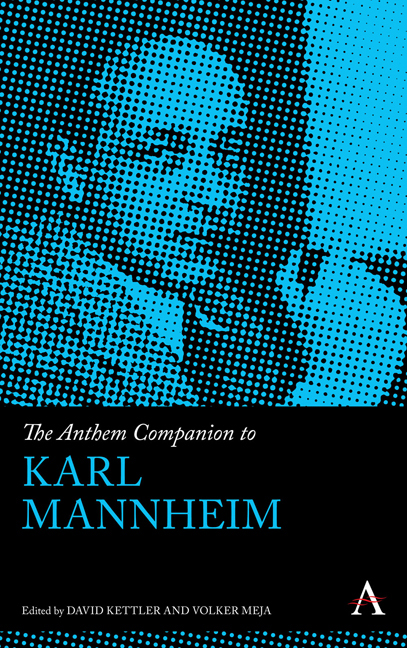Book contents
- Frontmatter
- Contents
- Introduction: Karl Mannheim as Interlocutor
- Chapter One Between Ideology and Utopia: Karl Mannheim's Quest for a Political Synthesis
- Chapter Two Karl Mannheim and the Realism Debate in Political Theory
- Chapter Three Mannheim, Mass Society and Democratic Theory
- Chapter Four Karl Mannheim and Hannah Arendt on Conduct, Action and Politics
- Chapter Five Karl Mannheim and Women's Research
- Chapter Six The Melodrama of Modernity in Karl Mannheim's Political Theory
- Chapter Seven Historicization and the Sociology of Knowledge
- Chapter Eight Karl Mannheim, T. S. Eliot and Raymond Williams: Cultural Sociology or Cultural Studies?
- Chapter Nine Karl Mannheim's Sociology of Self-Reflexivity
- Chapter Ten Praxeological Sociology of Knowledge and Documentary Method: Karl Mannheim's Framing of Empirical Research
- List of Contributors
- Index
Chapter Four - Karl Mannheim and Hannah Arendt on Conduct, Action and Politics
Published online by Cambridge University Press: 10 May 2018
- Frontmatter
- Contents
- Introduction: Karl Mannheim as Interlocutor
- Chapter One Between Ideology and Utopia: Karl Mannheim's Quest for a Political Synthesis
- Chapter Two Karl Mannheim and the Realism Debate in Political Theory
- Chapter Three Mannheim, Mass Society and Democratic Theory
- Chapter Four Karl Mannheim and Hannah Arendt on Conduct, Action and Politics
- Chapter Five Karl Mannheim and Women's Research
- Chapter Six The Melodrama of Modernity in Karl Mannheim's Political Theory
- Chapter Seven Historicization and the Sociology of Knowledge
- Chapter Eight Karl Mannheim, T. S. Eliot and Raymond Williams: Cultural Sociology or Cultural Studies?
- Chapter Nine Karl Mannheim's Sociology of Self-Reflexivity
- Chapter Ten Praxeological Sociology of Knowledge and Documentary Method: Karl Mannheim's Framing of Empirical Research
- List of Contributors
- Index
Summary
In this chapter I explore the triangle of relationships among Karl Mannheim, Max Weber and Hannah Arendt in order to clarify their respective conceptions of rationality, politics and action. While both Mannheim and Arendt had their differences with Weber, I argue that their exposure to his writings was formative for their own respective visions of how to theorize action. While Mannheim may be said to have advanced a theory of action that was contiguous with Weber's own, Arendt reacted to what she perceived to be deflationary tendencies within both Weber and Mannheim's accounts. Yet her criticisms are themselves born of an engagement with classical sociology that yielded a distinctive theory of action in its own right. Indeed, I argue that Weber's theory of action was seminal for understanding how both Mannheim and Arendt developed their main ideas, and how they came to understand ‘politics’. Their divergences from each other in these respects are also informative.
Max Weber and Action Theory
The problem of theorizing social action is fundamental to sociology. Yet this has not yielded a settled account of social action that could be unproblematically endorsed by the discipline as a whole. Within American sociology, there have been a number of innovative attempts to solve outstanding problems within Weber's general theory of action, most famously that of Talcott Parsons, who developed his own well- known approach largely through the prism of Weber's theory. Despite the widespread rejection of Parsons's approach by subsequent generations, action theory within American sociology still bears the distinctive stamp of his interpretation of Weber. This is visible in various assumptions that Parsons attributed to Weber, but which are more strictly Parsons's own. More seriously, perhaps, Parsons interprets Weber's action theory in terms of a sharp contrast between rational and nonrational action. This binary has been duplicated, to some extent, by subsequent action theory, although it has been subject to a variety of other interpretations. Most of these develop the relationship between means and ends inherent in each of the action types, doing so in order to expose ‘secondary’ or alternative action types – Robert Merton's social strain theory being the most prominent example of this. But, in Weber's own typology of action, there are not two but four types.
- Type
- Chapter
- Information
- The Anthem Companion to Karl Mannheim , pp. 71 - 84Publisher: Anthem PressPrint publication year: 2017

